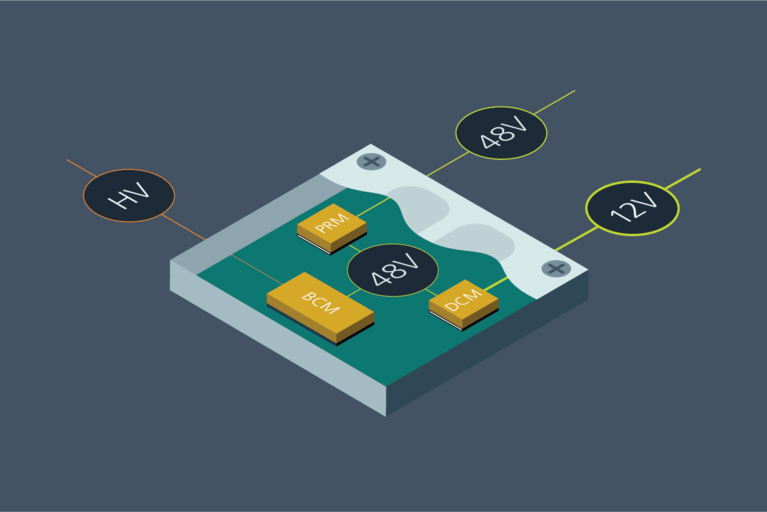
高密度功率模組簡化和縮小電動汽車電源系統設計
Vicor 電源模組為電動汽車應用注入創新。瞭解三款汽車級新產品將如何徹底改變未來的電源設計
Switching regulator solutions are offered in various levels of integration, offering a broad spectrum of performance, features, and packaging. They range from open frame discrete solutions to fully integrated modules.
Figure 1. Different levels of Integration in Regulator Solutions
There are numerous tradeoffs to each type of design, but the one that takes the lead in performance vs. cost for the 50W to 100W-type point-of-load design is the SiP-type regulator, especially when combined with a ZVS switching topology. These SiP-based regulators, like our Vicor ZVS regulators, are built on an over-molded substrate, which integrates power FETs, passive components, and predefined compensation components. This packaging approach integrates the majority of the regulator system except for the inductor and input/output capacitors.
With an external inductor, board-level heat dissipation is superior vs. the module approach where heat is concentrated in one location (the inductor can generate 40-50% of the total regulator heat). Without being constrained by package profile limitations external inductor design can be optimized for efficiency. Lower switching losses of the Vicor ZVS topology translate into higher efficiency, lower heat dissipation, and higher density. On the cost side, competitive modules from various IC vendors, including Vicor, typically hold a 1.5x to 3x premium over SiP-based regulators.
Considering that module performance lags vs. SiPs, and they cost more, designers might ask if the modules’ small gains in density are really worth it. At least for the Vicor-based SiP regulators, our density (power delivery vs. x-y board area consumption) is on par with modules, even when including all the required components (the external inductor and input/output capacitors). This is because the modules also require external input/output capacitance. Vicor’s ZVS topology supports high frequency operation (without sacrificing efficiency) and this allows for smaller passives.
Applications vary and hence there is a need for various levels of regulator integration, however, when looking at efficiency, size, and cost, our ZVS regulators set a performance/cost metric that surpasses that of many fully integrated modules. This can be counter intuitive to many designers especially when not aware of the added benefits of a ZVS switching topology regulator.
Related content
Product overview: ZVS buck switching regulators
高密度功率模組簡化和縮小電動汽車電源系統設計
Vicor 電源模組為電動汽車應用注入創新。瞭解三款汽車級新產品將如何徹底改變未來的電源設計
高密度電源模組推動主動懸架技術日趨成熟
主動懸掛系統已從 20 世紀 90 年代的測試版發展成為今天的 48V 驅動系統。瞭解電源模組對電源系統設計的影響
先進的電源模組封裝優化了自動駕駛電動巴士的可用功率、可靠性和安全性
Vicor 的高效電源模組確保最少的散熱,降低對複雜冷卻解決方案的需求,並最大限度地提升功率輸出
基於 MHz 開關頻率的器件助力實現 DC-DC 轉換器和 EMI 濾波器的小型化
想像一下,使用 DC-DC 轉換器解決方案來利用高頻開關的優勢,而不會發生傳統解決方案的缺點



